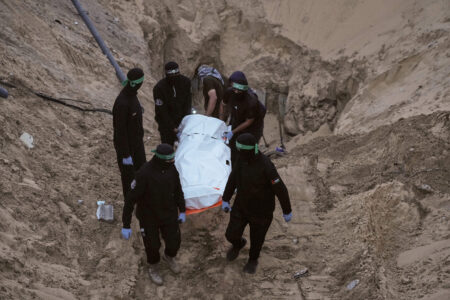Leadership West Virginia: Health care under microscope at Greenbrier Resort
- From left: Rob Aliff, an attorney for Jackson Kelly, leads a panel discussion Thursday with Steve Seftchick, a senior vice president for Highmark West Virginia; Melanie Dempsey, vice president for financial policy with the West Virginia Hospital Association; Sherri Ferrell, president and CEO of the West Virginia Primary Care Association; and Jim Nemitz, president of the West Virginia School of Osteopathic Medicine. (Photo by Steven Allen Adams)
- The site of the historic Greenbrier Resort was once a spa where people could soak in the sulfur water. Now, it is among the nation’s premiere resorts. (Photo by Steven Allen Adams)

From left: Rob Aliff, an attorney for Jackson Kelly, leads a panel discussion Thursday with Steve Seftchick, a senior vice president for Highmark West Virginia; Melanie Dempsey, vice president for financial policy with the West Virginia Hospital Association; Sherri Ferrell, president and CEO of the West Virginia Primary Care Association; and Jim Nemitz, president of the West Virginia School of Osteopathic Medicine. (Photo by Steven Allen Adams)
Editor’s Note: This is sixth in a seven-part series of columns about Leadership West Virginia, as well as the successes and challenges of W.Va. and different regions of the state.
WHITE SULPHUR SPRINGS — The historic Greenbrier Resort is more associated with its owner these days, but the posh hotel’s location has been known for more than 200 years for its therapeutic sulfur water.
It was fitting then for the Greenbrier to play host Thursday and Friday for the seventh Leadership West Virginia session focused on some of the state’s pressing health care issues.
“Health care is incredibly unique because it touches everything,” said Rob Aliff, an attorney for Jackson Kelly and a member of the Leadership West Virginia class of 2006. “None of us get by without having to deal with the health care system at some point, or someone in your family daily, weekly, monthly. That’s why we need to be a little bit more aware of what health care is and what it looks like in the State of West Virginia.”
“As a Leadership West Virginia class and us all being interested in advancing our state economically and keeping our folks here, it is also important to note the economic impact health care has on our state,” said Melanie Dempsey, vice president for financial policy with the West Virginia Hospital Association and a member of this year’s class.

The site of the historic Greenbrier Resort was once a spa where people could soak in the sulfur water. Now, it is among the nation’s premiere resorts. (Photo by Steven Allen Adams)
According to the 2022 America’s Health Rankings report published by the United Health Foundation, West Virginia ranked 48th out of 50 states for health outcomes; 49th for frequent mental distress; 49th for premature death (based on years lost before age 75 per 100,000 people); 49th for frequent physical distress; 49th for obesity; and 49th for multiple chronic health conditions.
According to the report, the state ranked 50th for drug deaths per 100,000 people and 50th for non-medical drug use. The percentage of drug deaths increased by 54% in one year, from 50.4 deaths per 100,000 people in 2019 to 77.4 deaths per 100,000 people in 2020.
Residents also perform poorly in statistics for health behaviors. The state ranked 45th for exercise, fruit and vegetable consumption and physical inactivity, while ranking 50th for smoking. Related to those statistics, West Virginia ranked 50th in preventable hospitalizations based on discharges per 100,000 Medicare beneficiaries. Yet, the state ranked ninth for dedicated health care providers.
During a discussion with health care experts, the panelists all agreed that before a dent can be made in the state’s poor health statistics, others surrounding health care need to be addressed, such as transportation to and from doctor visits, access to grocery stores and affordable healthy goods and broadband expansion for access to tele-health options.
“You really can’t address health without addressing everything that surrounds someone’s health,” said Steve Seftchick, a senior vice president for Highmark West Virginia. “In order to really address our health disparities, we need to address those fundamental social determinants of health needs for our population. That is hard, complex work … it’s going to take a village of all of us working on those things.”
“When do you go to the hospital? When do you go to the clinic? When you’re sick,” Dempsey said. “We’re not thought of as well-care providers; we’re thought of as sick-care providers. At least from the hospital standpoint, there is a drive to change that perception to not just take advantage of those health care services when you’re sick and it’s too late as a reactive situation … health care providers should be offering up programs to share a proactive approach, so we don’t get so low in the rankings.”
According to the 2022 County Health Ranking and Roadmaps, a project of the University of Wisconsin Population Health Institute, 14 southern West Virginia counties (Roane, Clay, Webster, Fayette, Cabell, Lincoln, Boone, Raleigh, Wayne, Mingo, Logan, Wyoming, McDowell and Mercer) are ranked at the bottom of health outcome rankings out of all 55 counties.
Counties in the state’s Eastern Panhandle (Berkeley, Jefferson) and Northern Panhandle (Ohio, Brooke) have some of the best health outcome rankings. Other top-ranked counties include Monongalia, Mineral, Tucker, Upshur, Doddridge, Gilmer, Pleasants, Jackson, Putnam and Monroe counties.
“The poverty conditions of communities must be addressed before the wellness of the community can be sustained,” said Sherri Ferrell, president and CEO of the West Virginia Primary Care Association. “Your zip code determines more about your health than anything else right now.”
Ferrell said the ability to track data across multiple spectrums is helping health care providers drill down to find the specific needs of communities and target resources towards those specific needs.
“Using data to help drive more resources to where they need to go is very important,” Ferrell said. “For us to collect it and start working with it … is the next step where we need to go.”
According to a community benefit report released earlier this year by the West Virginia Hospital Association, hospitals in the state have a $12.5 billion economic impact, employ more than 49,000 people and contribute more than $1 billion in local communities, including $177 million in uncompensated care.
However, an aging population with health care needs, a population with high poverty rates and poor health outcomes and a growing shortage of doctors, nurses and even emergency medical services is creating a perfect storm in West Virginia. Hospitals in the state are spending $97 million due to shortages of registered nurses, licensed practical nurses and nursing aids and techs. While there are 6,441 licensed beds in state hospitals, only 4,800 beds can be staffed.
Jim Nemitz, president of the West Virginia School of Osteopathic Medicine, said one of his focuses is production of new medical providers to meet the growing demand. But he said it is not just about producing new doctors but also how new doctors are trained to pay more attention to patient lifestyles and behaviors.
“There is a real need to focus on wellness care,” Nemitiz said. “You’re starting to see a change in medical schools to pay more attention to that. Because we know that the majority of chronic illnesses that people have are really related to lifestyle and related to behaviors. While we’re really good at training our providers to deal with all kinds of diseases, there tends to be a lack of attention on these basic things that keep people well.”
Another challenge for state hospitals and health care providers involves reimbursements. Only about a quarter of patients have private health insurance, while the remainder have Medicaid, Medicare and coverage through the Public Employees Insurance Agency.
All of these programs have different reimbursement rates, but all of them compensate health care providers below the actual cost of services, putting a financial strain on rural providers and hospitals. It also makes it harder for these hospitals to compete with hospitals and providers in bordering states that can offer higher pay and larger sign-on bonuses.
“Those nurses and other disciplines can very easily move within the market and take advantage of those financial incentives,” Dempsey said. “It is difficult. There are a lot of factors included.”
While West Virginia’s health care issues remain complicated and challenging, it is the focus of the industry itself, higher education and government.








